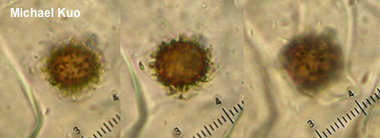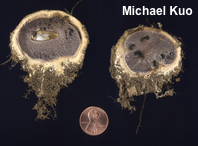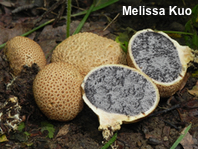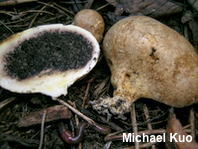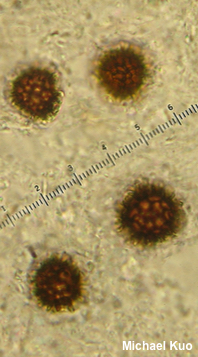| Major Groups > Puffballs & Others > Scleroderma |

|
[ Basidiomycota > Boletales > Sclerodermataceae . . . ] The Genus Scleroderma by Michael Kuo, 24 July 2025 Tough puffballs with blackish interiors, species of Scleroderma are sometimes called "earthballs" by field guide authors attempting to separate them from softer, fleshier puffballs. About 25 species of Scleroderma have been described world-wide, and many of these occur in North America. The easily recognized Scleroderma citrinum is well known and common, and famous for hosting the curious bolete Pseudoboletus parasiticus. Species of Scleroderma are mycorrhizal, and despite appearances are actually fairly closely related to the boletes. Species are separated primarily on the basis of physical features (especially microscopic analysis of their spores); contemporary, DNA-based treatment of the genus has yet to be published. Features to assess when studying collections of Scleroderma include the texture of the earthball's surface (bald, fibrillose, finely scaly, very scaly), and the thickness of the rind (the outer skin)—but here some notes are in order. First, it can be difficult with casual inspection to separate what is rind and what is immature flesh in young specimens. Eventually the flesh of Scleroderma specimens turns black and turns into spore powder, but in young specimens the flesh is white; in between these stages, the flesh can be black in the center and white towards the rind, making specimens appear to have thicker rinds than they actually do. Secondly, while Scleroderma literature is full of assessments of the rind's thickness, these measurements are usually taken from dried-up specimens stored for years in herbaria. As you can imagine, dried rinds are thinner than fresh ones. Some species regularly feature a pseudostem, while others usually do not. Scleroderma septentrionale, which grows in sand, usually creates a proportionally massive pseudostem in its attempt to lift itself above shifting sands, while Scleroderma polyrhizum usually lacks a pseudostem altogether. Bruising reactions on the surface of the earthball, along with color changes resulting from the application of KOH, may be more variable, and therefore less informative, than was previously thought (including by me). That said, it is still probably a good idea to note bruising and KOH reactions, at least until someone publishes a better idea. Distribution and ecology play important roles in identifying Scleroderma collections. Some species appear to be limited to certain areas, and many seem to be limited to association with certain trees—or at least to association with hardwoods or conifers. I have avoided paying the microscopic piper for as long as possible, but if you want to dance to his Scleroderma melodies, you're eventually going to have to pony up. Spore morphology is primarily what you will need to assess, and the spores of sclerodermas are easily accessed with mature, or even maturing specimens. Mount a clump of spore dust in KOH and proceed through your stages to oil immersion in order to view the spores. You will need to measure the spores, and assess the ornamentation on the spores. Spore measurements can be made with, or without, including the length (height) of the ornamentation—but it is crucial that you're clear on which method you're using, so that you can compare your measurements to those of your sources. By the way: sources are not always as clear as they should be about whether spore measurements include ornamentation or not; you may have to read the "methods" section of the source to discover what the author is doing. Assessing sporal ornamentation in Scleroderma is harder than it should be. While it is fairly easy to measure the length/height of the ornamentation, the genus as it is currently defined is broken up according to the reticulation on the spores. Section Scleroderma has non-reticulate-spored species, Section Sclerangium contains those with partially reticulate spores, and Section Reticulatae holds species with fully reticulate spores. Fine, but guess what? Reticulation on Scleroderma spores is hard to judge. Here are three photos of the same, single spore from a Scleroderma citrinum collection made in Indiana:
The first spore appears to have relatively isolated warts, without reticulation. The second spore is kind of blurry but might be construed as at least partially reticulate. The third spore is pretty reticulate. But this is only one spore! All I have done is roll the fine focus knob between the three photos. The photo on the left is actually the most accurate; the spore was not reticulate but did have occasional connecting lines. The reticulation illusion in the third photo is the result of the lens focusing on tips of spines that have joined together; when flattened out for the two-dimensional view the resulting pattern appears to be on the surface of the spore rather than hovering 2–3 µm above the spore's surface. The key below treats the North American species of Scleroderma as they are currently (2025) recognized. Several species from the former version of this key (2011) have since been synonymized with others, or recognized as probable misidentifications (see Guzmán et al. 2013; additionally I had Scleroderma cepa misidentified as "Scleroderma bovista" until now). However, it is quite possible that DNA-based study into the genus on our continent will make many of the current species concepts obsolete, so I don't recommend you get righteous about your Scleroderma identifications. |
|
|
References Binder, M. & Bresinsky, A. (2002). Derivation of a polymorphic lineage of Gasteromycetes from boletoid anscestors. Mycologia 94: 85–98. Coker, W. C. & Couch, J. N. (1928). The Gasteromycetes of the Eastern United States and Canada. Chapel Hill: University of North Carolina Press. Reprinted by Dover Publications, 1974. Guzmán, G. (1970). Monografía del género Scleroderma Pers. emend. Fr. (Fungi - Basidiomycetes). Darwiniana 16: 233–401. Guzmán, G. & Ovrebo, C. L. (2000). New observations on sclerodermataceous fungi. Mycologia 92: 174–179. Guzmán, G., F. Ramírez-Guillén, O. K. Miller, Jr., D. J. Lodge & T. J. Baroni (2004). Scleroderma stellatum versus Scleroderma bermudense: the status of Scleroderma echinatum and the first record of Veligaster nitidum from the Virgin Islands. Mycologia 96: 1370–1379. Guzmán, G., A. Cortés-Pérez, L. Guzmán-Dávalos, F. Ramírez-Guillén & M. del R. Sánchez-Jácome (2013). An emendation of Scleroderma, new records, and review of the known species in Mexico. Revista Mexicana de Biodiversidad 84: S173–S191. Guzmán-Dávalos, L. & G. Guzmán (1985). Hongos del estado de Jalisco, V. El genero Scleroderma. Revista Mexicana de Micologia 1: 109–128. Jeppson, M. (1998). Scleroderma septentrionale, a new gasteromycete from North-European sand dunes. Karstenia 38: 37–43. Jeppson, M. (2018). Scleroderma Pers.: Pers. In Knudsen, H. & J. Vesterholt, eds. Funga Nordica: Agaricoid, boletoid, clavarioid, cyphelloid and gastroid genera. Copenhagen: Nordsvamp, 207–209. Mrak, T., K. Hühdorf, T. Grebenc, I. Štrasu, B. Münzenberger & H. Kraigher (2017). Scleroderma areolatum ectomycorrhiza on Fagus sylvatica L. Mycorrhiza 27: 283–293. Ortiz-Rivero, J., R. Watling, L. Guzmán-Dávalos & M. P. Martín (2021). The many-rooted earthball--Scleroderma geaster and S. polyrhizum revisited, with the description of a new species. Phytotaxa 510: 001–017. Pinzón Osorio, C. A., A. Castiblanco Zerda & J. Pinzón Osorio (2018). Primer registro de Scleroderma verrucosum (Boletales, Sclerodermataceae) para Colombia. Revista de Ciencias 22: 29–41. Sims, K. P., Watling, R. & Jeffries, P. (1995). A revised key to the genus Scleroderma. Mycotaxon 56: 403–420. Smith, A. H. (1951). Puffballs and their allies in Michigan. Ann Arbor: University of Michigan Press. 131 p. This site contains no information about the edibility or toxicity of mushrooms. Cite this page as: Kuo, M. (2025, July). The genus Scleroderma. Retrieved from the MushroomExpert.Com Web site: http://www.mushroomexpert.com/scleroderma.html © MushroomExpert.Com |
